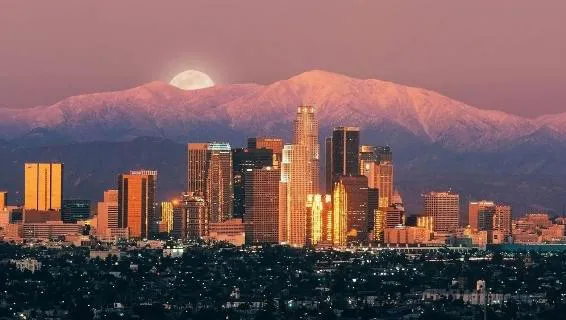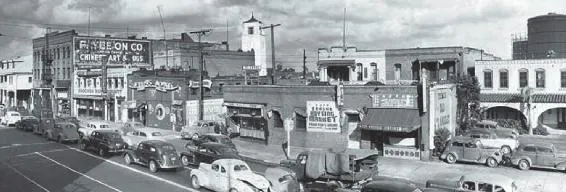![]()
CHAPTER ONE
SEVEN COUNTIES IN SOUTHERN CALIFORNIA WITH THE LARGEST CONCENTRATION OF THE CHINESE POPULATION
CHAPTER ONE
SEVEN COUNTIES IN SOUTHERN CALIFORNIA WITH
THE LARGEST CONCENTRATION OF THE CHINESE POPULATION
Southern California was the most important place of congregation for the early Chinese immigrants who spoke mainly Cantonese. After the 1943 repeal of the Chinese Exclusion Act of 1882 and the passage of Hart-Celler Act in 1965, waves of Chinese from Hong Kong, Taiwan, Southeast Asia and mainland China flooded into the U.S., with California as their primary destination After 1980, the Chinese population increased exponentially in the seven main counties in Southern California: Los Angeles, Orange, San Diego, San Bernardino, Riverside Ventura, and Santa Barbara. The economic and cultural scale of these Chinese communities experienced rapid expansion and the Chinese became an indispensable part of the population in the seven counties. Chinese developed their own politics, economy, culture, education, and fields closely related to their lives. At the same time, they made their presence known in the broader communities in these countries through their remarkable achievements. We will focus on the Chinese in Southern California in the decades since 1980. The new generation of the Chinese followed the footsteps of the older generation.
I. Los Angeles County
Los Angeles County is the most densely populated county in the U. S. According to the 2010 U.S. Census, it had a population of 9,818,605. Among them, 48.71 percent were white, 11.95 percent were Asian Americans and 9.78 percent were African Americans. There were 700 persons per sq. km., the highest population density in the U.S. Its total area was 4,752 sq. mi. (12,308 sq. km). Its area is larger than that of Rhode Island and the State of Delaware combined. The county has the San Gabriel Mountains on the east and the Pacific Ocean from San Pedro to Santa Monica on the west. Los Angeles is the largest of close to 90 cities in Los Angeles County and in California. It is the second largest city in the U.S after New York City. Los Angeles County has nearly one quarter of the population in California. It is the most ethnically diverse county in Southern California. Los Angeles, the “City of Angels” has the largest Chinese population in California
On the second day of Santa Maria Day 200 years ago, a Spanish missionary came to this small town, and called it “The town of the Queen of Angels,” It became Los Angeles, an authentic city in the eyes of many.
1. The Rise and Decline of the Old Chinatown
Los Angeles is so big, its landform so complex, and its highways so numerous and confusing that newcomers often get lost. To present a vivid and accurate picture of the city, we will follow the method introduced by the book “Tung wan lo san ji zhi lu” (通往洛杉磯之路) and imagine the city as one big clock with 12 fan-shaped sections. The center of the city is the center of the clock. Chinatown is situated near the northeast of the central point of the clock. From Broadway Street, one can see the building of the City Hall with the white peak scraping the sky. It is close to the south end of Sunset Blvd. The archway decorated with “Two Dragons Playing with a Pearl”, is the gate to Chinatown. The statute of Peter Soo Hoo司徒元發, the earliest civil right fighter in Los Angeles, the statue of Sun Yat-Sen erected by Chinatown Corporation大中華實業公司 in the Sun Yat-Sen Square中山廣場 are its landmarks.
An Old Chinatown site was demolished for parking lot and building of freeways. The picture was taken in 1948 of the North Los Angeles Street (Los Angeles Public Library Photo Archives)
The history of the Chinese in the Los Angeles region could be traced back to the mid-19th century. According to the census of 1850, two Chinese by the names of Ah Luce and Ah Fu worked as servants for Robert Harley, an American merchant. In 1861, there were 21 Chinese men and 8 Chinese women in the city. Most of them worked as laundry workers, cooks, and servants. In 1870, the number of the Chinese in Los Angeles increased to 172, but represented only 3 percent of the population. Chinese in Los Angeles increased from 605 in 1880 to 2111 in 1900 primarily due to Chinese workers on the construction of Southern Pacific Railroad and to Chinese moving from northern California to escape the violence toward Chinese following the passage of the 1882 Chinese Exclusion Act. During the 1870s Chinese gradually monopolized the laundry business. For example, in 1879, Chinese ran 90 percent of laundry businesses. There were over 300 Chinese employees in this line of business. Chinese also controlled the produce business and the supply of vegetable and fruits in Los Angeles region. In 1876, the number of Chinese vendors for vegetable and fruit was 52 while there were only two non-Chinese vendors. In 1879, the Chinese supplied 90 percent of the vegetable for the city.
As more and more Chinese moved to Los Angeles, a Chinatown began to form in Calle de los Negros (Nigger Alley). Gradually, it extended to other streets including Spring, Los Angeles, Main, Canal, and First. In 1882, there were 41 stores of various kinds in Chinatown, which included 18 laundry, 11 grocery stores and 2 stores each for ready-made-clothes, medicinal materials, meat and shoes-making. In 1887, the Chinatown in Los Angeles was burned to the ground in a fire that appeared to have been intentionally set. From 1869 to 1906, Chinatown was re-built in an area bounded by Alameda Street, Los Angeles Street, Apablasa Street, and Marchessault Street.
The Los Angeles Chinatown or “Luosheng” 羅省 as the old Cantonese-speaking immigrants called it used to be the place where Indians, Spaniards, Italians, Croatians, Chinese, and Southeast Asians lived. In 1850, the Chinese were not allowed to own real estate. They could only rented the place from the Apablasa family. Nigger Alley, where the early Chinese congregated, was the poorest region in this city. At the time, the Superior Court of California stipulated that all the colored people including Chinese may not own land, intermarry with whites or testify at court against whites.
By 1890, Los Angeles old plaza had basically been formed. The picture is of one corner of Chinatown near the plaza. (Peter Soo Hoo Sr. Collection)
In 1882, the U.S. Congress passed the Chinese Exclusion Act, forbidding the entry of Chinese labor immigrants. Those who were already in the U. S. could not have their families in China join them. In the old Chinatowns, most Chinese were coolies, laundry workers, and vendors. Viewed as expatriates from the Qing Empire with long queues, they faced mental as well as physical bullying and violence with little or no recourse from the legal system. Whites could destroy Chinatown and murder Chinese with impunity proving that. “A weak nation has no diplomatic clout.”
The anti-Chinese movement in American West began in the late 1860s. It reached the climax in the late 1880s. The early scholars mostly attributed the exclusionist movement to economic factors. For example, Hubert Howe Bancroft and Mary Roberts Coolidge argued that the root came from the discontent of the white labor organizations such as Workingmen’s Party, which held that Chinese coolies took whatever work was offered at low wages and therefore reduced white opportunities for employment. Scholars such as Elmer Clarence Sandmeyer re-examined the exclusionist movement from the perspectives of economy, race, morality and society and culture. Sandmeyer argued that the study of the exclusionist movement must consider racial discrimination hidden beneath the economic factor. The misunderstanding and discrimination on the basis of the Chinese outer appearances, lifestyle and cultural behaviors made Chinese coolies the scapegoats in the time of economic recession. This shows that the exclusionist movement was not based solely on the economic factor, and...



